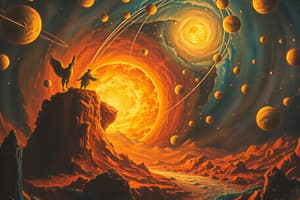Podcast
Questions and Answers
Who was NOT one of the proponents of the Nebular theory?
Who was NOT one of the proponents of the Nebular theory?
- Emanuel Swedenborg
- Immanuel Kant
- Pierre-Simon Laplace
- Harold Jeffreys (correct)
What is the main difference between the planetesimal theory and the tidal theory?
What is the main difference between the planetesimal theory and the tidal theory?
- One suggests ejections from the sun, the other does not.
- One focuses on a solid mass formation, the other on gas condensation. (correct)
- One emphasizes the role of asteroids, the other focuses only on stars.
- One involves the formation of moons while the other does not.
Which statement accurately describes the Encounter Theory?
Which statement accurately describes the Encounter Theory?
- It states that planets were formed from material ejected during a celestial encounter. (correct)
- It claims planets coalesced from the solar nebula without external influence.
- It suggests planets were formed by collision with comets.
- It proposes that planets formed from gases surrounding the sun.
Who proposed the planetesimal theory along with Chamberlin?
Who proposed the planetesimal theory along with Chamberlin?
What process is described by the tidal theory concerning the formation of planets?
What process is described by the tidal theory concerning the formation of planets?
What is a nebula?
What is a nebula?
What is the first major step in the formation of the solar system according to the nebular theory?
What is the first major step in the formation of the solar system according to the nebular theory?
Which of the following best describes planetesimals?
Which of the following best describes planetesimals?
What typically causes a cloud collapse in the nebular theory?
What typically causes a cloud collapse in the nebular theory?
Which type of planets are classified as terrestrial?
Which type of planets are classified as terrestrial?
What is one of the main characteristics of Jovian planets?
What is one of the main characteristics of Jovian planets?
Who is NOT considered a proponent of the nebular theory?
Who is NOT considered a proponent of the nebular theory?
What occurs to the radius of a cloud during its collapse according to the nebular theory?
What occurs to the radius of a cloud during its collapse according to the nebular theory?
Flashcards are hidden until you start studying
Study Notes
Nebular Theory
- The solar system formed from a nebula, a giant cloud of gas and dust in space.
- The nebula consisted of hydrogen, helium, and other ionized gases.
- The process began with a shockwave from a supernova or a passing star causing the cloud to collapse.
- Gravity pulled the cloud's center inward, increasing its spin speed as it contracted.
- As the cloud spun faster, it flattened into a disk called a protoplanetary disk.
- The center of the disk eventually became the Sun, and the remaining material formed the planets.
- Terrestrial planets, like Mercury, Venus, Earth, and Mars, are closer to the Sun and have higher metallic and silicate compounds.
- Jovian planets, like Jupiter, Saturn, Uranus, and Neptune, are farther from the Sun, allowing gas to condense due to lower temperatures.
Proponents of the Nebular Theory
- Emanuel Swedenborg
- Immanuel Kant
- Pierre-Simon Laplace
Encounter Theory
- Planets formed from material ejected from the Sun during a close encounter with another celestial object, such as a star.
Planetesimal Theory
- A form of the Encounter Theory.
- A passing star (intruding star) nearly collided with the Sun, causing it to eject filaments of material.
- These filaments condensed into planetesimals, small bodies that eventually collided and fused to form planets.
Proponents of the Planetesimal Theory
- Thomas Chrowder Chamberlin
- Forest Ray Moulton
Tidal Theory
- A near collision between the Sun and a passing star caused hot gas to be ejected from the Sun.
- This gas condensed into planets instead of planetesimals.
Proponents of the Tidal Theory
- James Jeans
- Harold Jeffreys
Studying That Suits You
Use AI to generate personalized quizzes and flashcards to suit your learning preferences.




